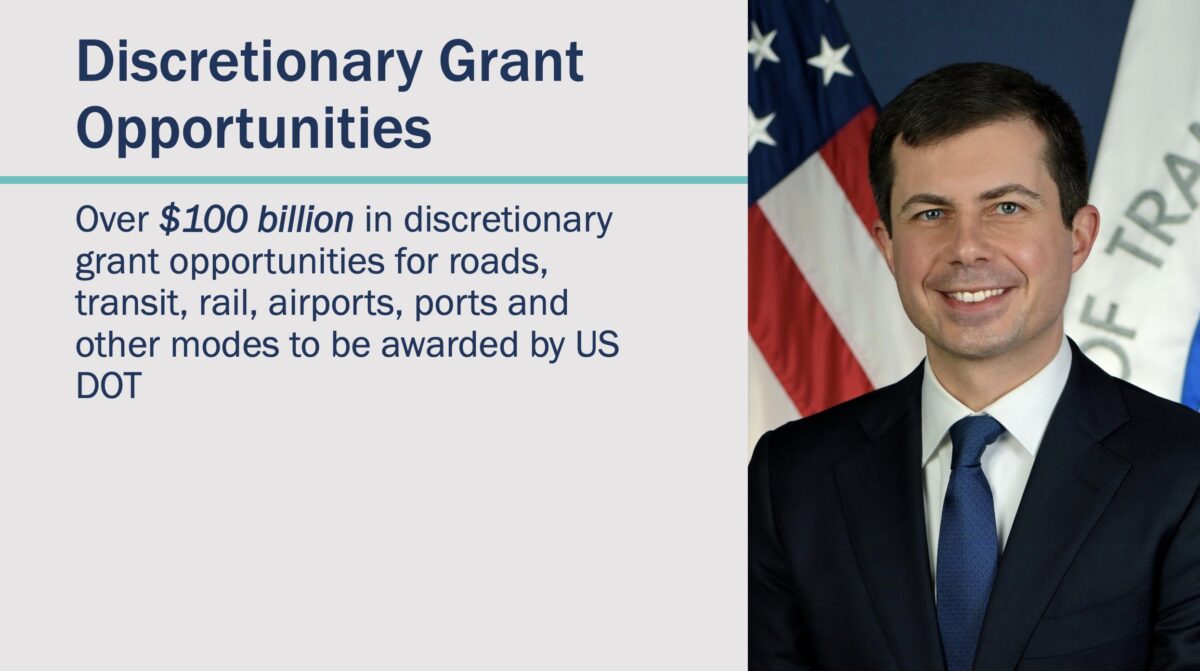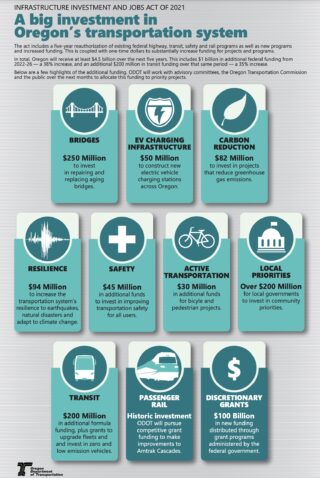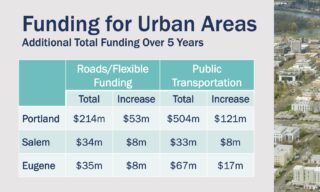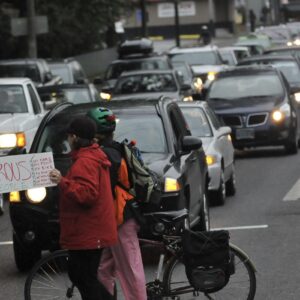
(Source: ODOT presentation)
Heads are spinning at the Oregon Department of Transportation over what’s being called a “truly historic” influx of federal cash thanks to passage of President Joe Biden’s Infrastructure Investment and Jobs Act (IIJA).
On a media call Friday, ODOT Assistant Director of Revenue, Finance and Compliance Travis Brouwer (who we talked to last week) shared a rough outline of how the money will be spent. When the presentation arrived at the pot of $100 billion in discretionary funding that U.S. Department of Transportation Secretary Pete Buttigieg will be in charge of, Brouwer said, “I put a slide up of Secretary Mayor Pete Buttigieg, because he’s going to be our new best friend.”
“He’s got $100 billion that he’s going to be able to dole out for competitive discretionary grant opportunities for all different types of transportation programs across the country, whether it’s road, transit, rail, airports, ports and other modes as well,” Brouwer continued. “So we are all going to be getting our grant writing pens out and spending a lot of time trying to bring additional money back to Oregon.”
Advertisement

Brouwer said given historic patterns, Oregon could net about $1 billion additional dollars (over five years) in discretionary grants. Key to his optimism is Oregon’s most recent transportation package, House Bill 2017, that primed the pump with $5.3 billion — some of which will be used as matching funds for these grants.

Details of Sec. Buttigieg’s program haven’t been released yet, but given his politics and past leanings, it’s likely that bicycling and transit projects will compete very well for the funds. This week Buttigieg has began to announce recipients of his RAISE grant program, and the winners – including $19 million for a bike-friendly rebuild of a street in Eugene – show a priority on multimodal and active transportation projects.
Another place where we can expect to see a boost in bicycling infrastructure spending will be the estimated $164 million in additional funding that will come into Portland from the IIJA over the next five years.
Also at Friday’s presentation, Brouwer said funding decisions will have to be made on a very short timeline. He thinks Oregon will see about $150 million that will have to “get out the door very quickly.”
ODOT typically has about four years of process to award funds to projects through its Statewide Transportation Improvement Program (STIP), but Brouwer says, “This go-round we have more like four months.”
And because this is federal funding, Oregon must obligate it to projects in the fiscal year or they have to send it back.
To get a sense of this quick timeline, Brouwer and ODOT plan to debrief the Oregon Transportation Commission (OTC) at their meeting Thursday (11/18). A timeline shown during last Friday’s presentation showed that ODOT expects to have its first public draft of various funding scenarios ready for public input by January and the OTC would make the final decision in March. That’s lightning-quick compared to other funding allocation processes.
So buckle up folks! It’s going to be a wild ride.
For more analysis of the bill, I recommend this article from Transit Center. I agree with their take: We should not despair and assume this bill will fund mostly freeway expansions and other car-centric projects. “It’s up to the public — and reformers inside government — to mobilize for good projects and prevent bad ones,” they write.






Thanks for reading.
BikePortland has served this community with independent community journalism since 2005. We rely on subscriptions from readers like you to survive. Your financial support is vital in keeping this valuable resource alive and well.
Please subscribe today to strengthen and expand our work.
ODOT is going to be able to greenwash so many projects with that money! I prefer my carbon-intensive road expansion to be greenwashed with all-organic unprotected bike lanes and fair trade increased speed limits.
I myself prefer my asphalt to be carbon-free and my elected officials to be biodegradable.
RE: mayor Pete being a potential ally of transit and bike projects, I’d say his history on that front is milquetoast, at best. I’m reminded of Neil Young’s characterization of George Bush senior’s foreign policy as ‘a kinder, gentler machine gun hand.’ yeah, he’ll be more receptive to allocating a portion of the funding to non freeway projects than the last adminstration was, but as long as the lion share is going to infrastructure that primarily supports SOV transportation, it’s all just window dressing. The fact that ODOT is salivating over this money should tell you all that you need to know.
A thumbs up for a Neil Young reference on Bike Portland.
Since the default mechanism is that all the federal USDOT money will be filtered (or siphoned off) through our state DOTs, we need to figure out a way to get as much of the money going directly to jurisdictions and nonprofits as possible, like the ARPA covid stimulus funds.
Biden today opened up 80 million acres in the Gulf of Mexico for new oil and gas production. Guess what forms of transportation benefit. Climate catastrophy and COP26 are oh, so yesterday.
Well since Americans are squealing like stuck pigs over a gas price increase and his approval is in the toilet, this is what you have to do…. Climate change behavior in this country is laughable. Obviously the public will never change on this issue, just happy talk until they get to the pump…
Mike: Biden’s hands were tied, as I understand it, once the oil states won their court battle to reopen the Trump era leasing process.
Cynicism so thick you can cut it with a knife. Geez people, this is the kind of news we’ve being dreaming about and praying for and doubting would ever happen since Obama left the White House. Yes, let’s hold ODOT accountable and be the alternative transportation watchdogs we need to be to see green active transportation projects to fruition. But it’s ok to celebrate this. It’s good news.
Yes, good news. But we better take the money and run. Repubs have already declared they will “renegotiate” the whole thing if they take back Congress next year.
If the GOP doesn’t cut the package, then you will get CRC2 AND Rose Quarter.
Yes, the fact that there is a Transportation Sec. who actually regularly uses bike share is a big deal. HOpefully he can follow through on more alternative transport funding.
Any chance we could get a grant to fund safety patrols and cleanup for our bike paths (I-205 and Springwater Corridor)? Sections are currently unusable or too dangerous for cyclists to use.
Clean up of the paths along ODOT roads is traditionally done by the county, by sending prison crews to do clean up. PP&R used to have rangers who did patrols, but I dare say that got cut long ago. Maybe bring back the PPD 4-hoofed mountain bike patrols, the kind that leave piles of green organic waste on the trails? I remember them in the late 90s.
I think the real issue here is less about bike infrastructure, but about how much of this money is going to be used by state DOTs to build new infrastructure instead of repairing existing infrastructure like they’re supposed to. New roads to new developments expand their tax base, which filling potholes and painting rusty bridges doesn’t do. Gotta keep that ponzi scheme going!
Except ODOT has clearly stated that the largest share of money is going to go to repairing bridges. So this take is just wrong. In fact, name one single “new road” project that this money will be used for. I doubt there’s going to be a single one (as there shouldn’t be).
Other state DOTs, sure. A lot of state DOT agencies (e.g. Utah DOT) are extremely regressive and just keep building new roads. But ODOT is not one of those. Apart from the Sunrise Expressway have there been any new highways built in the past few decades?
When you write, ‘repairing bridges,’ I can only assume that you mean exactly what ODOT means when it uses that term. When they say it, it’s a euphemism for widening and increasing capacity. The climate effects of increasing SOV vehicle throughput on existing freeways are just as devastating as building an entirely new freeway. But it’s much cheaper and easier to do.
Got a source or any evidence that says that’s what ODOT means? Yet more anti-ODOT rhetoric that is a common sentiment around here but that nobody can provide a single shred of evidence to back up. The CRC is one bridge; there’s thousands on the highway system that aren’t being widened for every one that is. Many (if not most) of which are structurally deficient or functionally obsolete, and need to be repaired or replaced, which is what this bill will do.
The recently completed I-205 project in Portland added lane miles and created a wider shoulder, that could potentially be used for additional lanes if they want to restripe in the future. The Rose quarter project is doing the same thing to I-5. The I-205 project that covers portions of the freeway in West Linn, Oregon City and Gladstone is nominally being marketed as a bridge replacement and seismic retrofit, but it is also adding new lanes and widening existing lanes, with potential for more restriping. And of course, as you mentioned, there’s the CRC. How many examples do you need?
The first two aren’t bridge projects, so totally irrelevant to the topic at hand. The Abernathy Bridge project, I’ll give you. But again, that’s two bridges out of thousands. We shall see what the funding ends up being used for.
You want more examples? How about the I-5 Boone bridge replacement project that is proposed in wilsonville? Still just a study, but the recommendations are to add lanes as part of the bridge replacement. It’s marketed as one of the seismic retrofits that you are referring to.
How about the I-105 bridge project that was just completed in Eugene? It added lanes.
If you dig into the details of ODOT seismic bridge projects, you’ll find that they typically add vehicle lanes.
Exactly what David said below. Again, for every bridge widened, there’s many that aren’t. How about bridges ilke Nerberry and Vermont on Barbur that need replacement and are certainly not going to have more vehicle lanes? Or the many, many overpasses over the freeways, like the 20 over 405 in the downtown area. Or the multitude of bridges on I-84 in the Columbia Gorge. Or the many on US 26 on the way to the coast. Many of those need retrofitting or replacement, and none are going to be widened. You’re cherry-picking the bridges that are at the regions of worst bottlenecks right now, and ignoring the many, many others that exist on the highway system.
Totally understood, but my point is that the big ticket projects, like the CRC, are going to gobble up a the majority of the build back better funds, and ODOT is definitely going to prioritize funding for projects that are considered to be seismic issues that also rate highly on their list of bottlenecks. They will fund those projects first. Yes, ODOT will request some money for retrofitting bridges throughout the highway system. But just like HB2017 and other past transportation bills in Oregon, their proposal will be dominated by massive capacity enhancement projects with a hodgepodge of smaller projects tacked on.
I think a more pertinent question is can you think of a single example of an ODOT bridge replacement or seismic retrofitting that didn’t result in a wider roadway?
The term “bridge” on a freeway and on highways include quite a lot of viaducts over soft ground, bogs, small streams, slopes, and anywhere else the ground isn’t firm enough to put a bed of gravel with reinforced concrete on top. Anywhere ODOT is “repairing” a roadway without widening it will usually include maintaining several viaducts.
I really hope we in the Gorge can get some of this money to finally retrofit the Hood River – White Salmon Bridge. The designs have been through public comment and I think are nearly through their environmental review. The plans for a wide multiuse path for bikes and peds is going to be a game changer for these communities and anyone who wants to take advantage of the incredible bike touring on both sides of the river.
It sounds great. That’s a toll bridge. Where does the toll money go?
From what I’ve heard some of that money is being saved to act as ‘local match’ and some go to other Port Activities since the tolls and bridge is managed by the Port of Hood River.
Yes the new verb of the year is : “obligate” “obligate” “obligate” .
I am happy to hear that ODT has been working locally to get the local match squared away as this is always the weak link (other than very slow local public process) when it comes to bike ped facilities…as the local match for active transportation always seems to be the most difficult to find even in the PNW.
“Obligate” sure beats “encumber”, the older term, but perhaps not the vernacular term of “commit”.
Re “ $19 million for a bike-friendly rebuild of a street in Eugene – show a priority on multimodal and active transportation ” The proposed rebuild of Franklin Boulevard in Eugene is a car-centric, suburban design featuring multiple roundabouts that will force pedestrians and cyclists to take long detours and crossings so cars can speed through intersections without stopping. The BRT will get an extra lane in one area, but lose signal priority. The long walking distances and crossings will make the area uninviting and dead, except for the swirling cars. The new bike paths will be an improvement over the current car sewer, but the city could have done so much more. Not a good example.